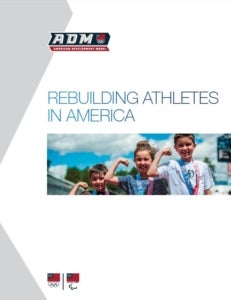
How well are stakeholders doing in making quality sport accessible and affordable to all kids, regardless of zip code or ability? How well are they serving the health of kids and communities? The Aspen Institute Sports & Society Program and its Project Play initiative take measure in “State of Play: 2016,” an annual snapshot that identifies 50+ key developments over the past year.
In the first week of the Rio Olympic Games, we explore five developments in the area of “Design for Development,” one of the eight strategies for eight sectors that touch the lives of children as identified in the 2015 Project Play report, “Sport for All, Play for Life: A Playbook to Get Every Kid in the Game,” a framework for action that more than 100 organizations have used to shape or introduce youth programming and a document identified as a key resource by the US and International Olympic Committees. Read the full “State of Play: 2016” report at http://as.pn/play2016.
If a local facility is the hardware in a child’s sport experience, then a developmentally appropriate program is the software. Leading sport governing bodies recognize it as the organizing framework to deliver what kids need to grow as both athletes and people. Adoption of it is seen as a tool to stem attrition, advance physical literacy, and debunk misperceptions that parents and coaches have about athletic development.
Five developments:
1- In January, the US Olympic Committee released guidance for stakeholders to implement its American Development Model (ADM).  An essential document in encouraging best practices in youth sports, the ADM describes athlete development principles that “allow American youth to utilize sport as a path toward an active and healthy lifestyle, and create opportunities for athletes to maximize their full potential.” Universal access for all athletes is the top priority, and stage one, for children ages zero to 12, is called Discover, Learn & Play. The new brochure offers specific guidance for five constituencies: national governingbodies, sport clubs, coaches, parents, and athletes. An ADM program for Paralympic athletes was also launched, supported by webinar tutorials.
An essential document in encouraging best practices in youth sports, the ADM describes athlete development principles that “allow American youth to utilize sport as a path toward an active and healthy lifestyle, and create opportunities for athletes to maximize their full potential.” Universal access for all athletes is the top priority, and stage one, for children ages zero to 12, is called Discover, Learn & Play. The new brochure offers specific guidance for five constituencies: national governingbodies, sport clubs, coaches, parents, and athletes. An ADM program for Paralympic athletes was also launched, supported by webinar tutorials.
2- A handful of the 48 NGBs sanctioned by the USOC are taking the critical next step, creating sport-specific ADM frameworks. To date, the USOC has not required it as a condition of membership. The NGBs that have created their own frameworks include wrestling, hockey, basketball, tennis, skiing/snowboarding, rugby, soccer, volleyball, track and field, and weightlifting. Baseball, lacrosse, and football are in progress. The NCAA also hosted summits to bring together NBGs, coaches, sport scientists and others to develop “clear and inclusive pathways in soccer, men’s basketball, and wrestling that support “wellness for life for all participants while allowing a pathway for elite sport development.” A women’s basketball summit is planned.
3- Notably, NGBs advanced efforts to institutionalize small-sided play. Building on USA Hockey’s success with cross ice hockey that divides a sheet of ice into three spaces and gets more kids on skates at lower cost per family, US Lacrosse recommended small-sided play from U7 to U15, starting with 3 V 3 play.The US Soccer Federation went a step further and mandated such formats through U12, with kids moving from 4 V 4 to 7 V 7 to 9 V 9 as they age up. Mandates from NGBs to affiliate youth-serving organizations have been rare, so observers are watching the move.
4- More attempts are being made by NGBs to accredit programs, providing a Good Housekeeping Seal of Approval of sorts for those that meet national standards. One of the key efforts launched in 2015 was by USA Basketball, given that basketball is the top sport for kids and the Wild West landscape of the youth circuit. Teams, leagues, associations, camps, clinics, event operators, schools, clubs, and other groups can apply. For organizations with more than 30 coaches, it’s free.
5- The nascent Sport-Based Youth Development (SBYD) methodology made strides in taking its place globally as a key agent in addressing a range of social issues, including health but also equity, crime reduction, and employability. UNESCO recognized as much in November 2015, adopting a revised International Charter on Physical Education, Physical Activity and Sport that has a more significant focus on sport as a tool for development and inclusion.

